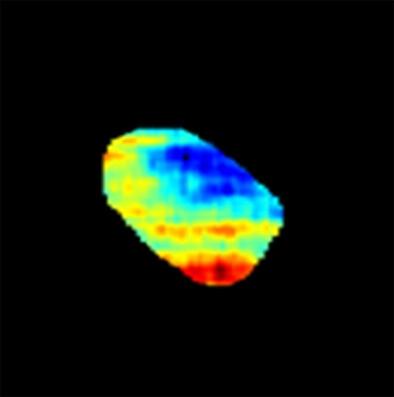当前位置:
X-MOL 学术
›
J. Biophotonics
›
论文详情
Our official English website, www.x-mol.net, welcomes your
feedback! (Note: you will need to create a separate account there.)
Use of photoacoustic imaging for monitoring vascular disrupting cancer treatments
Journal of Biophotonics ( IF 2.0 ) Pub Date : 2020-09-05 , DOI: 10.1002/jbio.202000209 Muhannad N Fadhel 1, 2, 3 , Sila Appak Baskoy 1, 2, 3 , Yanjie Wang 1, 2, 3 , Eno Hysi 1, 2, 3 , Michael C Kolios 1, 2, 3
Journal of Biophotonics ( IF 2.0 ) Pub Date : 2020-09-05 , DOI: 10.1002/jbio.202000209 Muhannad N Fadhel 1, 2, 3 , Sila Appak Baskoy 1, 2, 3 , Yanjie Wang 1, 2, 3 , Eno Hysi 1, 2, 3 , Michael C Kolios 1, 2, 3
Affiliation

|
Vascular disrupting agents disrupt tumor vessels, blocking the nutritional and oxygen supply tumors need to thrive. This is achieved by damaging the endothelium lining of blood vessels, resulting in red blood cells (RBCs) entering the tumor parenchyma. RBCs present in the extracellular matrix are exposed to external stressors resulting in biochemical and physiological changes. The detection of these changes can be used to monitor the efficacy of cancer treatments. Spectroscopic photoacoustic (PA) imaging is an ideal candidate for probing RBCs due to their high optical absorption relative to surrounding tissue. The goal of this work is to use PA imaging to monitor the efficacy of the vascular disrupting agent 5,6-Dimethylxanthenone-4-acetic acid (DMXAA) through quantitative analysis. Then, 4T1 breast cancer cells were injected subcutaneously into the left hind leg of eight BALB/c mice. After 10 days, half of the mice were treated with 15 mg/kg of DMXAA and the other half were injected with saline. All mice were imaged using the VevoLAZR X PA system before treatment, 24 and 72 hours after treatment. The imaging was done at six wavelengths and linear spectral unmixing was applied to the PA images to quantify three forms of hemoglobin (oxy, deoxy and met-hemoglobin). After imaging, tumors were histologically processed and H&E and TUNEL staining were used to detect the tissue damage induced by the DMXAA treatment. The total hemoglobin concentration remained unchanged after treatment for the saline treated mice. For DMXAA treated mice, a 10% increase of deoxyhemoglobin concentration was detected 24 hours after treatment and a 22.6% decrease in total hemoglobin concentration was observed by 72 hours. A decrease in the PA spectral slope parameters was measured 24 hours after treatment. This suggests that DMXAA induces vascular damage, causing red blood cells to extravasate. Furthermore, H&E staining of the tumor showed areas of bleeding with erythrocyte deposition. These observations are further supported by the increase in TUNEL staining in DMXAA treated tumors, revealing increased cell death due to vascular disruption. This study demonstrates the capability of PA imaging to monitor tumor vessel disruption by the vascular disrupting agent DMXAA.
中文翻译:

使用光声成像监测破坏血管的癌症治疗
血管破坏剂破坏肿瘤血管,阻断肿瘤生长所需的营养和氧气供应。这是通过破坏血管的内皮衬里,导致红细胞 (RBC) 进入肿瘤实质来实现的。存在于细胞外基质中的红细胞暴露于外部压力源,导致生化和生理变化。这些变化的检测可用于监测癌症治疗的疗效。光谱光声 (PA) 成像是探测红细胞的理想候选者,因为它们相对于周围组织具有高光吸收率。这项工作的目标是使用 PA 成像通过定量分析监测血管破坏剂 5,6-二甲基氧杂蒽酮-4-乙酸 (DMXAA) 的功效。然后,将 4T1 乳腺癌细胞皮下注射到八只 BALB/c 小鼠的左后腿中。10 天后,一半的小鼠接受 15 mg/kg 的 DMXAA 处理,另一半则注射生理盐水。在治疗前、治疗后 24 小时和 72 小时,使用 VevoLAZR X PA 系统对所有小鼠进行成像。成像是在六个波长下完成的,线性光谱分离被应用于 PA 图像以量化三种形式的血红蛋白(含氧、脱氧和高铁血红蛋白)。成像后,对肿瘤进行组织学处理,并使用 H&E 和 TUNEL 染色检测由 DMXAA 处理引起的组织损伤。盐水处理的小鼠在处理后总血红蛋白浓度保持不变。对于 DMXAA 处理的小鼠,在处理后 24 小时检测到脱氧血红蛋白浓度增加 10%,22. 到 72 小时时观察到总血红蛋白浓度降低 6%。处理后 24 小时测量 PA 光谱斜率参数的降低。这表明 DMXAA 会引起血管损伤,导致红细胞外渗。此外,肿瘤的 H&E 染色显示有红细胞沉积的出血区域。这些观察结果得到 DMXAA 处理的肿瘤中 TUNEL 染色增加的进一步支持,表明血管破裂导致的细胞死亡增加。这项研究证明了 PA 成像监测血管破坏剂 DMXAA 对肿瘤血管破坏的能力。导致红细胞外渗。此外,肿瘤的 H&E 染色显示有红细胞沉积的出血区域。这些观察结果得到 DMXAA 处理的肿瘤中 TUNEL 染色增加的进一步支持,表明血管破裂导致的细胞死亡增加。这项研究证明了 PA 成像监测血管破坏剂 DMXAA 对肿瘤血管破坏的能力。导致红细胞外渗。此外,肿瘤的 H&E 染色显示有红细胞沉积的出血区域。这些观察结果得到 DMXAA 处理的肿瘤中 TUNEL 染色增加的进一步支持,表明血管破裂导致的细胞死亡增加。这项研究证明了 PA 成像监测血管破坏剂 DMXAA 对肿瘤血管破坏的能力。
更新日期:2020-09-05

中文翻译:

使用光声成像监测破坏血管的癌症治疗
血管破坏剂破坏肿瘤血管,阻断肿瘤生长所需的营养和氧气供应。这是通过破坏血管的内皮衬里,导致红细胞 (RBC) 进入肿瘤实质来实现的。存在于细胞外基质中的红细胞暴露于外部压力源,导致生化和生理变化。这些变化的检测可用于监测癌症治疗的疗效。光谱光声 (PA) 成像是探测红细胞的理想候选者,因为它们相对于周围组织具有高光吸收率。这项工作的目标是使用 PA 成像通过定量分析监测血管破坏剂 5,6-二甲基氧杂蒽酮-4-乙酸 (DMXAA) 的功效。然后,将 4T1 乳腺癌细胞皮下注射到八只 BALB/c 小鼠的左后腿中。10 天后,一半的小鼠接受 15 mg/kg 的 DMXAA 处理,另一半则注射生理盐水。在治疗前、治疗后 24 小时和 72 小时,使用 VevoLAZR X PA 系统对所有小鼠进行成像。成像是在六个波长下完成的,线性光谱分离被应用于 PA 图像以量化三种形式的血红蛋白(含氧、脱氧和高铁血红蛋白)。成像后,对肿瘤进行组织学处理,并使用 H&E 和 TUNEL 染色检测由 DMXAA 处理引起的组织损伤。盐水处理的小鼠在处理后总血红蛋白浓度保持不变。对于 DMXAA 处理的小鼠,在处理后 24 小时检测到脱氧血红蛋白浓度增加 10%,22. 到 72 小时时观察到总血红蛋白浓度降低 6%。处理后 24 小时测量 PA 光谱斜率参数的降低。这表明 DMXAA 会引起血管损伤,导致红细胞外渗。此外,肿瘤的 H&E 染色显示有红细胞沉积的出血区域。这些观察结果得到 DMXAA 处理的肿瘤中 TUNEL 染色增加的进一步支持,表明血管破裂导致的细胞死亡增加。这项研究证明了 PA 成像监测血管破坏剂 DMXAA 对肿瘤血管破坏的能力。导致红细胞外渗。此外,肿瘤的 H&E 染色显示有红细胞沉积的出血区域。这些观察结果得到 DMXAA 处理的肿瘤中 TUNEL 染色增加的进一步支持,表明血管破裂导致的细胞死亡增加。这项研究证明了 PA 成像监测血管破坏剂 DMXAA 对肿瘤血管破坏的能力。导致红细胞外渗。此外,肿瘤的 H&E 染色显示有红细胞沉积的出血区域。这些观察结果得到 DMXAA 处理的肿瘤中 TUNEL 染色增加的进一步支持,表明血管破裂导致的细胞死亡增加。这项研究证明了 PA 成像监测血管破坏剂 DMXAA 对肿瘤血管破坏的能力。


















































 京公网安备 11010802027423号
京公网安备 11010802027423号